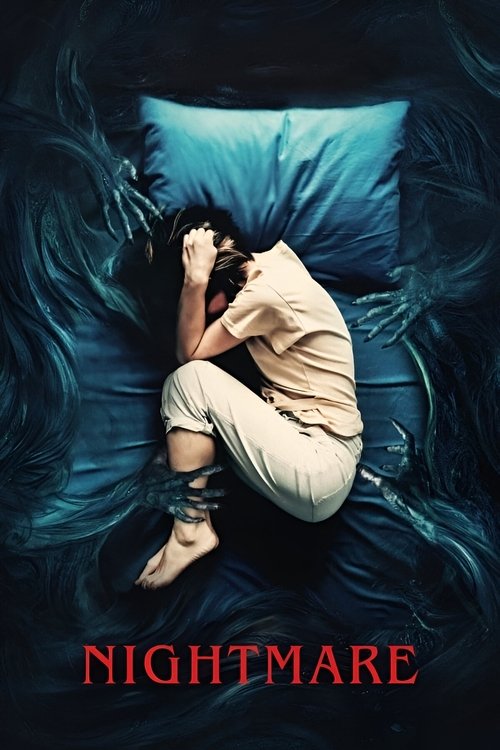
Ask Your Own Question
What is the plot?
On a bright, sunny morning, Lana, a woman burdened by years of routine, drags an old, worn office chair to the curb. The chair, once a trusted companion in her daily life, now discarded like refuse, seems to harbor a dark, malevolent will. As Lana steps away, the chair sits silently on the roadside, its presence heavy with unspoken resentment and a sinister sentience that lingers in the air.
Not long after, Reese, a young man portrayed by Anthony Pavone, drives past the chair and is inexplicably drawn to it. Without hesitation, he pulls over, eyes fixed on the oddly compelling piece of furniture. The chair's aura seems to beckon him, and Reese decides to take it home as a surprise gift for his girlfriend, an act that unknowingly sets a terrifying chain of events into motion. He places the chair prominently in their living room, where it immediately feels out of place--an unsettling, almost unnatural object dominating the space.
Reese's girlfriend, whose name remains unmentioned but whose presence is deeply felt, reacts with immediate discomfort and fear. She pleads with Reese, her voice trembling with unease, begging him to get rid of the chair. "Please, Reese, just throw it away. It's... it's wrong," she implores, her eyes darting nervously toward the chair as if it might spring to life. But Reese, initially dismissive, is already beginning to feel a strange attachment to the chair, unaware that it is slowly infiltrating his mind.
As days pass, the chair's influence grows more insidious. Reese experiences subtle but disturbing hallucinations--shadows flicker at the edges of his vision, whispers echo in empty rooms, and his grip on reality begins to falter. The chair seems to watch him, its silent malevolence pressing on his psyche. His girlfriend's demeanor shifts unpredictably; one moment she is loving and concerned, the next she is cold and hostile, as though the chair's darkness is seeping into her soul as well.
Reese's memory starts to betray him. He cannot recall dropping the chair off somewhere, nor does he remember an entire week passing. The boundaries of time and reality blur, and the chair's power to distort perception becomes terrifyingly clear. At one point, Reese returns home to find the chair already in place, brought back by his girlfriend, who claims it has "grown on her." Reese's confusion deepens--he has no memory of her moving it, and the growing paranoia isolates him further.
Outside the house, an eerie figure appears--an old man who seems inexplicably connected to the chair. Reese witnesses the man hitting his head with a hard object, blood trickling down his face, a haunting image that suggests the chair's curse has a long, dark history. The old man's self-harm may be a manifestation of the chair's influence or a warning of the madness that awaits those who fall under its spell. This spectral presence adds a layer of dread, implying that Reese's torment is not unique but part of a cyclical nightmare.
Inside the house, tension escalates. Reese confronts his girlfriend during one of her sudden personality shifts. "Who are you?" he demands, desperation cracking his voice. She answers with a chilling smile, "I'm whoever the chair wants me to be." The room seems to close in on them, shadows lengthening, the chair looming ominously between them. Reese's attempts to resist the chair's control only deepen his psychological unraveling.
Despite the mounting horror, no physical deaths occur in the film. The terror is psychological, a slow erosion of sanity rather than a series of violent acts. Reese's internal battle with the chair's influence is the central conflict, his mind a battlefield where reality and nightmare merge. The girlfriend's shifting personalities and the old man's mysterious self-harm are manifestations of the chair's supernatural power to corrupt and consume.
The climax arrives as Reese's mental state collapses utterly. He finds himself sitting once again on the chair at the very curb where he first found it, the scene mirroring the film's opening. This cyclical return suggests that Reese is trapped in an endless loop of torment, the chair's malevolent spirit having claimed him completely. The final moments are heavy with ambiguity and dread, leaving Reese's ultimate fate grim and unresolved. The chair remains, silent and watchful, its dark power undiminished, ready to ensnare the next victim in its cursed cycle.
Throughout the film, the chair symbolizes jealousy, possession, and the darkness lurking within the human mind. Its silent presence transforms familiar spaces into sites of horror, warping time and reality, and driving those around it toward madness. Reese's story is a haunting exploration of psychological torment, where the boundary between supernatural possession and internal madness is indistinguishable, culminating in a chilling narrative of inescapable evil.
What is the ending?
In the ending of the movie "Chair," the main character, a professor named Dr. Joan Hambling, faces a pivotal moment in her career and personal life. After a series of conflicts regarding her teaching methods and the changing dynamics of academia, she ultimately decides to resign from her position. This decision leads to a moment of reflection and acceptance of her identity and values. The film concludes with Joan embracing her future, leaving behind the constraints of her past.
As the final scenes unfold, we find Dr. Joan Hambling sitting in her cluttered office, surrounded by stacks of papers and books that represent her years of dedication to academia. The atmosphere is heavy with tension as she contemplates her next steps. The camera lingers on her face, capturing the mix of anxiety and determination in her expression. She has been at the center of controversy due to her unconventional teaching style, which has drawn both admiration and criticism from students and faculty alike.
In a pivotal scene, Joan meets with the university administration, where she is confronted about her teaching methods and the complaints that have been lodged against her. The room is stark and sterile, contrasting with the warmth of her passion for teaching. As she listens to the criticisms, her internal struggle becomes palpable. She feels the weight of the expectations placed upon her, and the frustration of being misunderstood. The dialogue is sharp, revealing the deep divide between her ideals and the institution's rigid standards.
After the meeting, Joan retreats to a quiet corner of the campus, where she reflects on her journey. The camera captures her solitude, emphasizing her isolation in a world that seems to have moved on without her. She recalls moments of joy in the classroom, the connections she made with students, and the passion that once fueled her. This introspection leads her to a moment of clarity; she realizes that she cannot compromise her values for the sake of conformity.
In the following scene, Joan gathers her belongings from her office, a symbolic act of letting go. As she packs her books and personal items, she is joined by a few supportive students who express their gratitude for her influence on their lives. Their presence serves as a reminder of the impact she has had, even in the face of adversity. The emotional weight of this farewell is palpable, as Joan acknowledges the bittersweet nature of her departure.
The climax of the film occurs when Joan makes the decision to resign. She stands before the administration one last time, her voice steady but filled with emotion. She articulates her reasons for leaving, emphasizing the importance of authenticity in education and the need for change within the academic system. This moment is powerful, as it encapsulates her journey from a conflicted professor to a woman reclaiming her voice.
As the film draws to a close, we see Joan walking away from the university, the campus fading into the background. The sun sets, casting a warm glow that symbolizes new beginnings. In her final moments on screen, Joan is seen sitting on a park bench, a serene expression on her face as she watches the world around her. This scene signifies her acceptance of the unknown future ahead, free from the constraints of her past.
The fates of the main characters are intertwined with Joan's journey. The students who supported her are left inspired, carrying forward the lessons they learned from her. The administration, while losing a passionate educator, is left to grapple with the implications of their rigid policies. Joan's decision to leave represents a broader commentary on the struggles faced by educators in a changing academic landscape, highlighting the importance of staying true to oneself amidst external pressures.
Is there a post-credit scene?
In the movie "CHAIR," produced in 2020, there is no post-credit scene. The film concludes its narrative without any additional scenes or content after the credits roll. The story wraps up with a focus on the main character's journey and the resolution of the central themes, leaving the audience with a sense of closure.
What challenges does the main character face in their academic career?
The main character, Dr. Joan Hambling, faces significant challenges in her academic career as she navigates the pressures of leading a struggling English department at a prestigious university. She grapples with the expectations of her colleagues, the demands of her students, and the looming threat of budget cuts that could jeopardize her department's future.
How does Dr. Joan Hambling's relationship with her colleagues evolve throughout the film?
Dr. Joan Hambling's relationship with her colleagues is fraught with tension and conflict. Initially, she feels isolated and unsupported, particularly from her male counterparts who question her leadership abilities. As the story progresses, she begins to assert herself, leading to both confrontations and moments of solidarity, ultimately revealing the complexities of academic politics and gender dynamics.
What role does the character of Bill play in Dr. Hambling's journey?
Bill, a charismatic and controversial professor, serves as both a mentor and a source of conflict for Dr. Hambling. His unconventional teaching methods and disregard for traditional academic norms challenge her to reconsider her own values and approach to education. Their interactions are charged with tension, as she grapples with her admiration for his passion and her frustration with his lack of accountability.
How does the film portray the impact of budget cuts on the university's English department?
The film vividly illustrates the impact of budget cuts on the English department through scenes of faculty meetings filled with anxiety and uncertainty. The threat of losing faculty positions and resources creates a palpable sense of urgency, forcing Dr. Hambling and her colleagues to confront their own vulnerabilities and the precarious nature of their academic careers.
What internal conflicts does Dr. Hambling experience regarding her leadership style?
Dr. Hambling experiences significant internal conflict regarding her leadership style as she struggles between being assertive and maintaining her integrity. She often questions whether to conform to the aggressive tactics of her male colleagues or to stay true to her values of collaboration and support. This internal struggle is depicted through her moments of self-doubt and her interactions with both students and faculty.
Is this family friendly?
The movie "CHAIR," produced in 2020, contains several themes and scenes that may not be suitable for children or sensitive viewers. Here are some potentially objectionable aspects:
-
Emotional Turmoil: The film explores deep emotional struggles, including themes of loss, grief, and personal failure, which may be distressing for younger audiences.
-
Substance Abuse: There are references to substance use and the impact it has on relationships, which could be unsettling for some viewers.
-
Mental Health Issues: The characters grapple with mental health challenges, including anxiety and depression, which are depicted in a raw and realistic manner.
-
Conflict and Tension: The film features intense family conflicts and arguments that may be uncomfortable for children to witness.
-
Mature Themes: The narrative delves into adult relationships and the complexities of personal choices, which may not be appropriate for younger viewers.
These elements contribute to a narrative that is more suited for mature audiences, as they may evoke strong emotional responses and require a level of understanding that younger viewers may not possess.



















